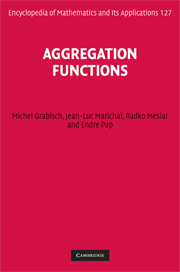Book contents
- Frontmatter
- Contents
- List of figures
- List of tables
- Preface
- 1 Introduction
- 2 Properties for aggregation
- 3 Conjunctive and disjunctive aggregation functions
- 4 Means and averages
- 5 Aggregation functions based on nonadditive integrals
- 6 Construction methods
- 7 Aggregation on specific scale types
- 8 Aggregation on ordinal scales
- 9 Aggregation on bipolar scales
- 10 Behavioral analysis of aggregation functions
- 11 Identification of aggregation functions
- Appendix A Aggregation of infinitely many arguments
- Appendix B Examples and applications
- List of symbols
- References
- Index
1 - Introduction
Published online by Cambridge University Press: 05 March 2013
- Frontmatter
- Contents
- List of figures
- List of tables
- Preface
- 1 Introduction
- 2 Properties for aggregation
- 3 Conjunctive and disjunctive aggregation functions
- 4 Means and averages
- 5 Aggregation functions based on nonadditive integrals
- 6 Construction methods
- 7 Aggregation on specific scale types
- 8 Aggregation on ordinal scales
- 9 Aggregation on bipolar scales
- 10 Behavioral analysis of aggregation functions
- 11 Identification of aggregation functions
- Appendix A Aggregation of infinitely many arguments
- Appendix B Examples and applications
- List of symbols
- References
- Index
Summary
Main motivations and scope
The central problem we are investigating in this book is that of aggregation, which refers to the process of combining and merging several (most often numerical) values into a single one. Perhaps the oldest example in this respect is the notion of arithmetic mean or average, which has been used during all the history of physics and all experimental sciences. Any function like the arithmetic mean computing a single output value from an (arbitrarily long) vector of input values is called an aggregation function.
Aggregation functions play an important role in many of the technological tasks scientists are faced with nowadays. They are specifically important in many problems related to the fusion of information. More generally, aggregation functions are widely used in pure mathematics (e.g., functional equations, theory of means and averages, measure and integration theory), applied mathematics (e.g., probability, statistics, decision mathematics), computer and engineering sciences (e.g., artificial intelligence, operations research, information theory, engineering design, pattern recognition and image analysis, data fusion, automated reasoning), economics and finance (e.g., game theory, voting theory, decision making), social sciences (e.g., representational measurement, mathematical psychology) as well as many other applied fields of physics and natural sciences. Thus, a main characteristic of the aggregation functions is that they are used in a large number of areas and disciplines.
The essence of aggregation is that the output value computed by the aggregation function should represent or synthesize “in some sense” all individual inputs, where quotes are put to emphasize the fact that the precise meaning of this expression is highly dependent on the context.
Information
- Type
- Chapter
- Information
- Aggregation Functions , pp. 1 - 10Publisher: Cambridge University PressPrint publication year: 2009
